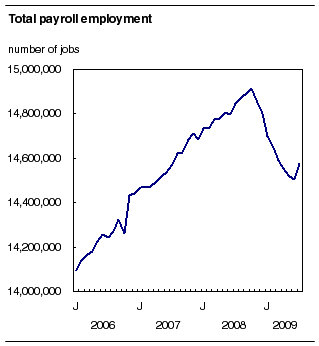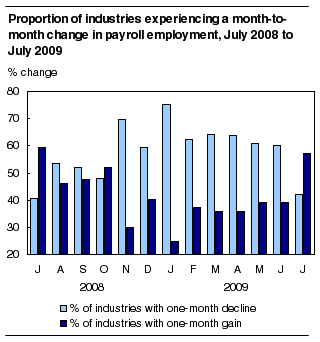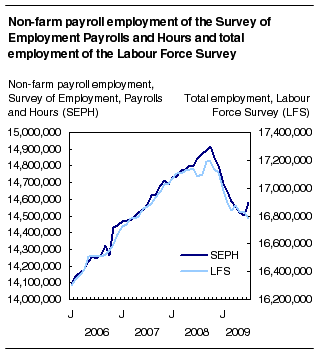Common menu bar links
Payroll employment, earnings and hours
Archived Content
Information identified as archived is provided for reference, research or recordkeeping purposes. It is not subject to the Government of Canada Web Standards and has not been altered or updated since it was archived. Please "contact us" to request a format other than those available.
Total non-farm payroll employment rose by 74,300 in July, up 0.5% from June. This was the first increase since payroll employment peaked in October 2008. The proportion of industries experiencing job gains rose for the third consecutive month in July to 57%, up from 47% in June.

These data come from the Survey of Employment, Payrolls and Hours (SEPH). SEPH is a business survey that provides a detailed portrait of employees from an industry perspective, complementing information on total employment from the Labour Force Survey (LFS), which is a survey from a household perspective.
Note to readers
Unless otherwise specified, data in this release refer to payroll employment and earnings data obtained from the Survey of Employment, Payrolls and Hours (SEPH).
Each month, Statistics Canada now provides enhanced analysis of the current labour market situation, using SEPH and other sources. The Labour Force Survey (LFS) will provide the first picture of overall labour market conditions, with unemployment and total employment and who is affected by changes in the labour market. Later in the month, Statistics Canada will provide additional detail by industry through the SEPH Daily release, and regional detail through the Employment Insurance statistics.
With the release of January 2009 SEPH data on March 31, 2009, an improved estimation method for earnings and hours data was introduced and estimates back to 2001 were revised to ensure continuity in data series.
Data on the education sector
Changes in payroll employment in education during the summer months can be affected by changes in payment schedules and school year calendars. Month-to-month changes should therefore be interpreted with caution, and more attention given to long-term trend.
In July, 174 of the 305 industries covered by the survey posted gains, up from 144 industries in June. This was the largest proportion of industries with a monthly increase in payroll employment since July 2008, when 181 industries were adding jobs.

The service sector accounted for the vast majority (82%) of the growth in payroll employment in July. The largest increase occurred in elementary and secondary schools, but there were also gains in a number of other service industries.
There was also growth in payroll employment in a number of goods-producing industries. The largest increase was in motor vehicle manufacturing which rose by 4,000 in July, its largest one-month gain since August 2005. Motor vehicle plants increased output in July as some assembly lines resumed production following extended shutdowns in recent months.
Payroll employment grew in nearly all provinces in July, with the biggest gains in Quebec, Ontario and Alberta. Nova Scotia was the only province without job growth.
The increase in payroll employment in July coincides with other indicators that point to changes in labour market conditions in recent months. The Labour Force Survey has shown that total employment, including the self-employed, increased or was little changed in three of the five months between April and August. This was in contrast to the consistent, large declines over the previous five months. Also, the number of people receiving Employment Insurance benefits fell in July, the first such decline in 11 months.
While up in July, total non-farm payroll employment remains 335,400 (-2.2%) below the peak of October 2008.
Average weekly earnings of payroll employees stood at $824.00 in July, up 1.6% from July 2008.
Bulk of growth in payroll employment from service sector
The number of payroll employees in elementary and secondary schools rose 33,800 in July. There was also growth in community colleges and collège d'enseignement général et professionel (CEGEPs) (+2,500) as well as school and employee bus transportation (+2,100).
General medical and surgical hospitals reported an increase in the number of payroll employees in July, up 3,800 from June. There were also gains in health and personal care stores (+2,200). Many health-related industries have continued to experience growth in payroll employment since the start of the economic downturn, with the overall health care and social assistance sector growing by 2.6% since October 2008.
Of the industries that have had growth in payroll employment since October 2008, many had strong ties to the public sector. These included other provincial and territorial public administration (+21,200), federal protective services (+9,900), and nursing care facilities (+8,000).
In July, the number of payroll employees working at full-service restaurants increased by 3,700, the first increase in the industry since December 2008.
Other service industries recording gains in July were architectural, engineering and related services (+2,500), paper, paper product and disposable plastic product wholesaler-distributors (+2,300) and individual and family services (+2,100).
Despite the widespread growth in the service sector, there were also some notable declines in certain service industries in July. These included business support services (-2,600), printing and related support activities (-2,200), radio and television broadcasting (-1,900) and performing arts companies (-1,400).
Gains in motor vehicle manufacturing and natural resources
The number of payroll employees working in motor vehicle manufacturing rose by 4,000 in July, the largest one-month gain since August 2005. Despite this gain, payroll employment in this industry has declined by 6,100, or 14%, since October 2008.
Support activities for mining, oil and gas extraction reported an increase of 3,000 in payroll employment in July. Similarly, there were increases in some related industries, with gains in both metal ore mining (+1,200) and oil and gas extraction (+1,200).
Despite July's increases, payroll employment in support activities for mining, oil and gas extraction, as well as metal ore mining remained 21% below their level in October 2008, the start of the economic downturn.
Average weekly earnings
Average weekly earnings of payroll employees stood at $824.00 in July, up 1.6% from July 2008. This was comparable to the 1.4% increase in average weekly earnings between June 2008 and June 2009. However, it was considerably slower than the most recent year-over-year peak of 3.0% in October 2008.
Within Canada's largest industrial sectors, the fastest pace of growth in average weekly earnings between July 2008 and July 2009 occurred in educational services (+6.9%), public administration (+4.1%) and health care and social assistance (+3.3%).
At the same time, average weekly earnings fell in manufacturing (-5.5%), accommodation and food services (-2.9%), as well as retail trade (-0.4%).
Newfoundland and Labrador experienced the fastest increase (+6.0%) in average weekly earnings between July 2008 and July 2009. Manitoba had the second fastest rate of growth (+4.3%), followed by Prince Edward Island (+4.2%) and Alberta (+4.0%). Two provinces had year-over-year earnings growth below the national average: Ontario (+1.1%) and Quebec (+0.7%).
Total hours
Total hours worked including overtime by hourly paid employees fell by 1.7% between July 2008 and July 2009. This was the third consecutive month of year-over-year declines in total hours worked. In October 2008, prior to the start of the economic downturn, year-over-year growth in total hours, including overtime by hourly paid employees, was 6.5%.
Comparing SEPH and LFS
Data on employment, wages and hours worked are produced by two major Statistics Canada monthly surveys: LFS and SEPH. Survey estimates differ for conceptual reasons and for methodological reasons. The information source is the key distinction between the two surveys: SEPH provides information related to occupied jobs based on a census of administrative data from businesses whereas LFS provides information on the employment characteristics of individuals based on a survey of households. As a result, from time to time, the estimates from the surveys can differ on a monthly basis. However, over the longer term, the estimates move in similar directions.
Since each of these surveys addresses different needs, the choice of data depends on the users' goals. Other conceptual and methodological differences between the two surveys include: degree of coverage of industries and the self-employed, treatment of multiple-job holders, and the survey reference period. The effects of these differences vary by industry.

Available on CANSIM: tables 281-0023 to 281-0039 and 281-0041 to 281-0046.
Definitions, data sources and methods: survey number 2612.
Detailed industry data, data by size of enterprise based on employment, and other labour market indicators will be available soon in the monthly publication Employment, Earnings and Hours (72-002-X, free).
Data on payroll employment, earnings and hours for August will be released on October 29.
For more information, or to order data, contact Client Services (toll-free 1-866-873-8788; 613-951-4090; labour@statcan.gc.ca). To enquire about revisions, concepts, methods or data quality of this release, contact Danielle Zietsma (613-951-4243), Labour Statistics Division.
Table 1
| Industry Group (North American Industry Classificiation System) | December 2008 | July 2008 | June 2009r | July 2009p | June to July 2009 | July 2008 to July 2009 | December 2008 to July 2009 |
|---|---|---|---|---|---|---|---|
| Seasonally adjusted | |||||||
| thousands | % change | ||||||
| Industrial aggregate | 14,800.4 | 14,845.1 | 14,504.2 | 14,578.4 | 0.5 | -1.8 | -1.5 |
| Forestry, logging and support | 44.7 | 47.1 | 38.6 | 39.1 | 1.3 | -17.0 | -12.5 |
| Mining and quarrying, and oil and gas extraction | 203.5 | 204.8 | 176.7 | 181.2 | 2.5 | -11.5 | -11.0 |
| Utilities | 122.7 | 119.8 | 119.8 | 118.6 | -1.0 | -1.0 | -3.3 |
| Construction | 817.7 | 837.9 | 785.2 | 784.3 | -0.1 | -6.4 | -4.1 |
| Manufacturing | 1,599.6 | 1,679.5 | 1,473.2 | 1,474.6 | 0.1 | -12.2 | -7.8 |
| Wholesale trade | 753.7 | 759.2 | 726.9 | 727.4 | 0.1 | -4.2 | -3.5 |
| Retail trade | 1,884.0 | 1,911.6 | 1,866.9 | 1,868.0 | 0.1 | -2.3 | -0.8 |
| Transportation and warehousing | 696.7 | 698.4 | 672.9 | 673.6 | 0.1 | -3.6 | -3.3 |
| Information and cultural industries | 326.3 | 325.9 | 323.4 | 324.8 | 0.4 | -0.3 | -0.5 |
| Finance and insurance | 666.4 | 659.0 | 667.5 | 668.3 | 0.1 | 1.4 | 0.3 |
| Real estate and rental and leasing | 246.8 | 254.8 | 240.3 | 240.8 | 0.2 | -5.5 | -2.4 |
| Professional, scientific and technical services | 766.6 | 753.7 | 733.9 | 738.5 | 0.6 | -2.0 | -3.7 |
| Management of companies and enterprises | 121.3 | 125.3 | 116.3 | 117.2 | 0.8 | -6.5 | -3.4 |
| Administrative and support, waste management and remediation services | 754.2 | 782.0 | 715.2 | 719.4 | 0.6 | -8.0 | -4.6 |
| Educational services | 1,147.5 | 1,126.9 | 1,153.6 | 1,188.2 | 3.0 | 5.4 | 3.5 |
| Health care and social assistance | 1,567.2 | 1,526.2 | 1,576.6 | 1,584.0 | 0.5 | 3.8 | 1.1 |
| Arts, entertainment and recreation | 242.1 | 240.7 | 251.4 | 253.5 | 0.8 | 5.3 | 4.7 |
| Accommodation and food services | 1,095.3 | 1,075.7 | 1,058.9 | 1,063.8 | 0.5 | -1.1 | -2.9 |
| Other services (excluding public administration) | 510.5 | 510.8 | 505.0 | 505.0 | 0.0 | -1.1 | -1.1 |
| Public administration | 1,024.4 | 999.6 | 1,033.5 | 1,039.6 | 0.6 | 4.0 | 1.5 |
| Provinces and territories | |||||||
| Newfoundland and Labrador | 192.4 | 191.0 | 187.3 | 188.8 | 0.8 | -1.2 | -1.9 |
| Prince Edward Island | 61.5 | 60.6 | 63.1 | 63.2 | 0.2 | 4.3 | 2.8 |
| Nova Scotia | 393.0 | 396.8 | 391.5 | 391.0 | -0.1 | -1.5 | -0.5 |
| New Brunswick | 311.0 | 315.7 | 308.8 | 310.7 | 0.6 | -1.6 | -0.1 |
| Quebec | 3,393.1 | 3,375.7 | 3,350.0 | 3,385.3 | 1.1 | 0.3 | -0.2 |
| Ontario | 5,671.0 | 5,718.0 | 5,524.7 | 5,558.7 | 0.6 | -2.8 | -2.0 |
| Manitoba | 562.8 | 565.0 | 561.9 | 564.0 | 0.4 | -0.2 | 0.2 |
| Saskatchewan | 439.9 | 435.0 | 439.4 | 439.7 | 0.1 | 1.1 | 0.0 |
| Alberta | 1,789.8 | 1,780.1 | 1,713.6 | 1,730.7 | 1.0 | -2.8 | -3.3 |
| British Columbia | 1,935.0 | 1,946.1 | 1,885.6 | 1,893.3 | 0.4 | -2.7 | -2.2 |
| Yukon | 19.5 | 19.5 | 19.3 | 19.1 | -1.0 | -2.1 | -2.1 |
| Northwest Territories¹ | 26.8 | 28.0 | 27.4 | 27.6 | 0.7 | -1.4 | 3.0 |
| Nunavut¹ | 10.1 | 10.3 | 10.2 | 10.5 | 2.9 | 1.9 | 4.0 |
Table 2
| Industry Group (North American Industry Classificiation System) | July 2008 | June 2009r | July 2009p | June to July 2009 | July 2008 to July 2009 |
|---|---|---|---|---|---|
| Seasonally adjusted | |||||
| $ | % change | ||||
| Industrial aggregate | 810.96 | 820.11 | 824.00 | 0.5 | 1.6 |
| Forestry, logging and support | 964.42 | 835.10 | 781.42 | -6.4 | -19.0 |
| Mining and quarrying, and oil and gas extraction | 1,538.35 | 1,651.81 | 1,602.20 | -3.0 | 4.2 |
| Utilities | 1,434.11 | 1,477.94 | 1,499.91 | 1.5 | 4.6 |
| Construction | 995.72 | 1,062.99 | 1,059.80 | -0.3 | 6.4 |
| Manufacturing | 960.88 | 907.67 | 908.02 | 0.0 | -5.5 |
| Wholesale trade | 943.52 | 1,002.40 | 994.74 | -0.8 | 5.4 |
| Retail trade | 480.94 | 476.47 | 478.86 | 0.5 | -0.4 |
| Transportation and warehousing | 883.54 | 877.80 | 874.54 | -0.4 | -1.0 |
| Information and cultural industries | 1,000.24 | 1,100.23 | 1,057.79 | -3.9 | 5.8 |
| Finance and insurance | 997.10 | 1,025.17 | 1,030.39 | 0.5 | 3.3 |
| Real estate and rental and leasing | 790.74 | 803.37 | 774.26 | -3.6 | -2.1 |
| Professional, scientific and technical services | 1,079.98 | 1,141.67 | 1,099.42 | -3.7 | 1.8 |
| Management of companies and enterprises | 1,057.24 | 1,137.17 | 1,162.59 | 2.2 | 10.0 |
| Administrative and support, waste management and remediation services | 684.70 | 658.38 | 680.22 | 3.3 | -0.7 |
| Educational services | 844.40 | 860.66 | 903.08 | 4.9 | 6.9 |
| Health care and social assistance | 746.49 | 774.80 | 770.94 | -0.5 | 3.3 |
| Arts, entertainment and recreation | 502.37 | 511.26 | 536.76 | 5.0 | 6.8 |
| Accommodation and food services | 335.39 | 324.97 | 325.58 | 0.2 | -2.9 |
| Other services (excluding public administration) | 672.91 | 688.51 | 712.30 | 3.5 | 5.9 |
| Public administration | 1,040.38 | 1,075.74 | 1,083.37 | 0.7 | 4.1 |
| Provinces and territories | |||||
| Newfoundland and Labrador | 759.86 | 795.85 | 805.49 | 1.2 | 6.0 |
| Prince Edward Island | 671.33 | 690.46 | 699.36 | 1.3 | 4.2 |
| Nova Scotia | 720.47 | 728.05 | 733.51 | 0.7 | 1.8 |
| New Brunswick | 739.51 | 738.96 | 754.12 | 2.1 | 2.0 |
| Quebec | 769.54 | 767.12 | 775.11 | 1.0 | 0.7 |
| Ontario | 836.07 | 841.43 | 845.17 | 0.4 | 1.1 |
| Manitoba | 748.04 | 767.71 | 780.26 | 1.6 | 4.3 |
| Saskatchewan | 785.22 | 801.16 | 803.90 | 0.3 | 2.4 |
| Alberta | 906.46 | 954.57 | 942.62 | -1.3 | 4.0 |
| British Columbia | 784.20 | 794.47 | 799.36 | 0.6 | 1.9 |
| Yukon | 847.52 | 895.65 | 879.55 | -1.8 | 3.8 |
| Northwest Territories¹ | 1,081.22 | 1,119.04 | 1,128.70 | 0.9 | 4.4 |
| Nunavut¹ | 920.36 | 882.70 | 866.38 | -1.8 | -5.9 |

